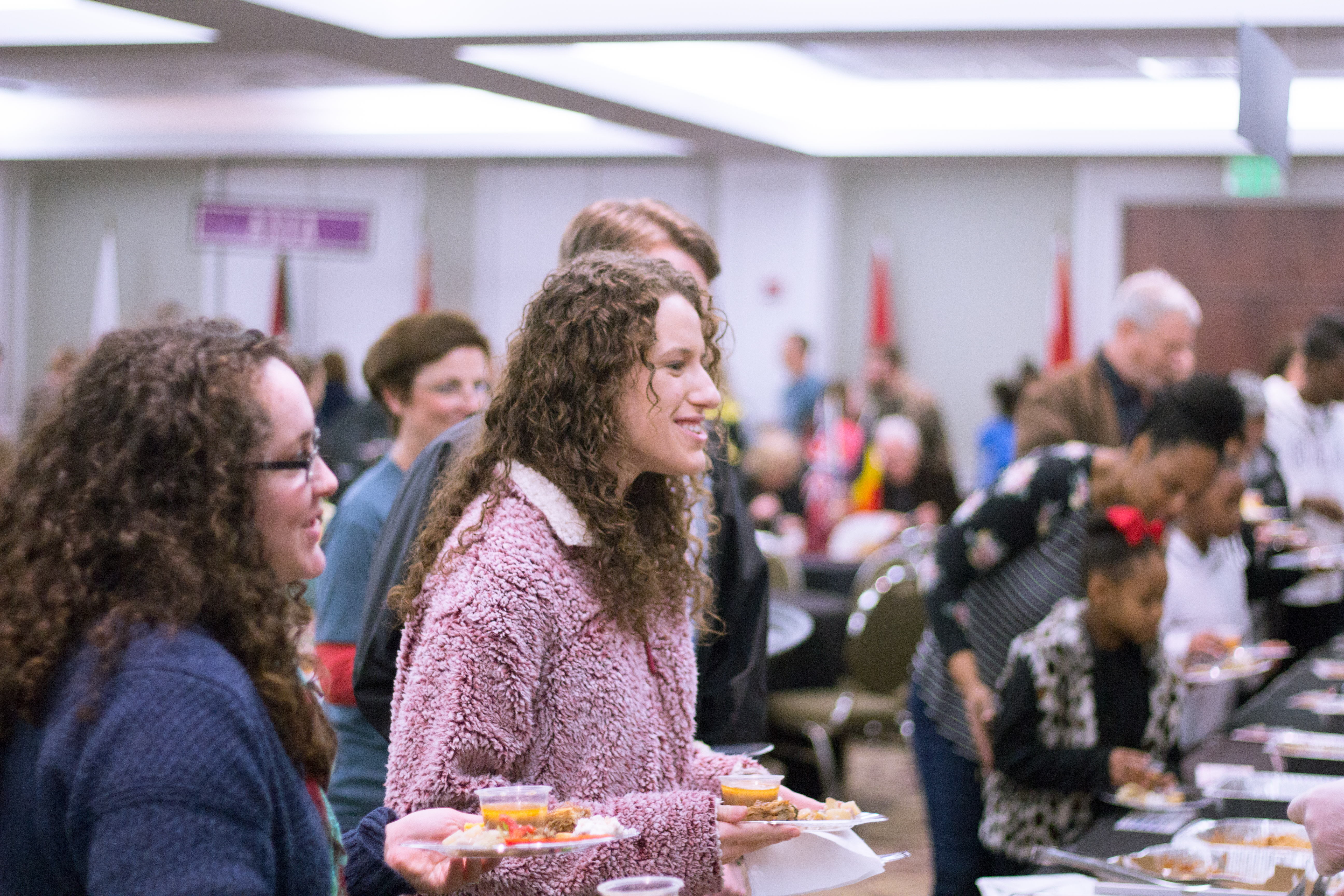a href=”https://www.obusignal.com/wp-content/uploads/2011/05/little-rock-central-high.jpg”> Desegregation: An Honors Seminar
Desegregation: An Honors Seminar
Part 3 of 5
Fifteen honors students contemplated the desegregation of public schools through research on the movement’s early days and trips to key sites in the history of the Civil Rights Movement. The students visited the museum and toured the school at the Little Rock Central High School National Historic Site. Having just read Melba Beals’ Warriors Don’t Cry, the students saw the exterior of the building, where African-American students were initially denied entrance, as well as the cafeteria, hallways and auditorium where the Little Rock Nine persevered through the integration of Central High in 1957.
The honors students researched desegregation in their home towns or in nearby areas and produced portfolios detailing their findings. They also viewed the documentary Hoxie: The First Stand and read Black Like Me, by John Howard Griffin. The one-hour seminar concluded with a trip to the National Civil Rights Museum in Memphis.
In an earlier essay assignment, students were asked to reflect on their visit to Little Rock and on the book by Beals, one of African-American students who integrated Central High amid turmoil and national news coverage in 1957. Five of those reflection papers are listed here. The authors are: Sarah Greeson, a senior from Hot Springs; Jesse Pruett, a senior from Harrison; Kiley Gamble, a junior from McKinney, Texas; Michelle Wasmund, a freshman from Dennison, Texas; and Anna Wakeling, a freshman from Bryant.
Others students in the seminar were: T.J. Bailey, a sophomore from Ft. Smith; Kimberly Carlton, a senior from Brandon, Miss.; Kasa Cooper, a senior from Paragould; Ethan Day, a sophomore from Garland, Texas; Anthony Emerson, a sophomore from Fresno, Texas; Jacob Lively, a senior from Queen City, Texas; Nate Peace, a junior from Bedford, Texas; Jessica Reid, a sophomore from Grandview, Texas; Nolan West, a senior from Bolivar, Missouri; and Clark Whitney, a freshman from Searcy. The course was taught by Dr. Kevin Motl, assistant professor of history, and Dr. Jeff Root, professor of communications and dean of the school of humanities.
Lessons from Melba Beals
Kiley Gamble
What is humanity and what are we capable of? Are hatred and prejudice part of the makeup of our species, or can we avoid them? Once, when I was growing up, we got two types of chicks from the feed store. Even though we raised them together, one type eventually began picking at the other type, pulling their feathers out and pushing them away on the roost. They had no mirrors, no capacity to reason, yet somehow they still felt they were different. Why do humans feel the need to form groups and put other groups down? Does it make us feel powerful? Are we no better than mindless chickens looking at the color of feathers? Reading Melba Beals’ memoir of desegregation, Warriors Don’t Cry, and making my own visit to Little Rock’s Central High, I imagined what it would have been like in her shoes, to be told I was less of a person because of my skin. First, I struggled to grasp everything she went through, and then I struggled with what I could draw from it. Certainly we can look to Melba Beals herself as a role model in standing up for what is right, but even broader than that, we should draw on her experience as a revealing look at human nature, a cautionary glimpse inside our very souls.
At first, as I read about the cruelty of Melba’s fellow students, I struggled to grasp that people could be capable of such callousness. I have dealt with my share of ugliness from my peers, but I cannot imagine students standing by while a group of boys attack a girl in a hallway. I have never had acid thrown in my eyes or had flaming wads of paper aimed at my head while I am in the restroom. Just reading the book, I felt vague shivers of fear dance up and down my spine. The utter helplessness of her situation felt unbearable to me, even at the comfortable distance of over 50 years. It seems difficult to believe that the other students could not recognize the similarities between her and them, that they could not see her as just another schoolgirl trying to go about her day. Even if they had grown up with all sorts of erroneous assumptions, surely the experience of seeing how harmless and human the black students were should have had some effect on them. Walking the halls of Central High in Little Rock, I felt a sense of unreality, the feeling you might get if you had a nightmare, then visited the scene of the nightmare and discovered it was all real. As a homeschooler, it was my first time to ever stand in a crowded school hallway and watch the other students go past. I felt some nervousness, but it was nothing compared to what Melba must have felt. I felt like I had stepped into a scene of a movie, and it forced me to put myself into those white students’ shoes. Would I have done anything differently?
I struggled to find an answer to the question Melba wrote in her diary, “Can they really be treating me this way simply because I am brown, that’s all?” (Beals 163). There must be a part of every person that blocks out the parts we do not want to see or hear. The Little Rock students had no problem seeing the darkness of Melba’s skin, yet they failed to see the human suffering in her eyes, failed to see the earnest effort she put forth in her classes, failed to see her natural intelligence and obvious gift with words. I think in the end, many failed to see her as an individual at all. The only times I have heard people criticize a group, they spoke about the group as a whole. When they mentioned certain members of the group they knew, they always described those members as exceptions, “the smart ones.” Melba knew this impersonal aspect of hatred, “As soon as those students got to know us, I had total faith they would realize how wrong they had been about our people” (Beals 32). Some students probably did regret her suffering, but were too afraid to speak up. I wonder if I would have risked sharing her torments to give her a whispered encouragement. It is one thing to stand up today and say I would have condemned the racists and another thing to face the condemnation of my entire world as those students did.
Melba herself set an admirable example of how to stand up for the truth, even when everyone seemed against her. As she made it clear at the end of her account, she did not let the treatment she suffered make her bitter. She said Central High was “ultimately a positive force that shaped the course of [her] life” (Beals 222). This definitely spoke to me, because I know that in her position I would have been very bitter. It showed me that more than being passionate about her cause, Melba truly understood it. Any bitterness on her part would only work against the reconciliation she fought for. Instead of letting the segregationists win, she rose above them. My favorite quote from Warriors Don’t Cry was her Grandma India’s advice, “Dignity is a state of mind, just like freedom. These are both precious gifts from God that no one can take away unless you allow them to” (Beals 164). I was inspired by the way Melba clung to her faith, praying for those who persecuted her. Another lesson I took from reading about her experience was the way she always highlighted the positive. Even when her days seemed like a constant uphill struggle, she still remembered the rare smiles from students in the hall, the compliments on her speech in chapel. We can all focus on the negative aspects of our lives, but if Melba could find bright points in her experience at Central High, I know I can certainly find things to appreciate each day as well. She shone as an example of the possibility of human kindness, even when all around her were being cruel.
Watching videos of hate-filled segregationist speeches at the museum near Central High, I was somewhat overwhelmed with the ugliness within our human nature. In another documentary on desegregation, Hoxie: The Last Stand, I noted similar tirades, people so angry they spit and raved on camera. Something else, however, caught my eye: pictures from the first day of integration showed black and white children getting along easily, waiting in line for the swing, talking under a tree, holding hands. This seemed like obvious evidence, in my mind, that if their parents had not gotten involved, these children would have never known the difference. It seemed like proof that racism is a learned cultural division; integration could have happened without violence. In Melba’s story, I think Link is a good example of this. He struggled with keeping his parents happy, while at the same time feeling sympathy from his experience with a beloved black nanny. I wonder: if he had had supporting parents, would he have been less secretive about his friendship with Melba? I find it interesting that Melba refused to date Link because he was white, but she later married a white man. Perhaps this is because a certain level of conditioning cannot be reversed. Certainly she did not resent Link’s whiteness, but perhaps she noticed his struggle to overcome ingrained prejudice. Perhaps this was why the students at Central High were so much crueler and less accepting than the young children in Hoxie. They had already reached that level of conditioning that resists being reversed.
This poses a question of great relevance to today’s progress: if we become aware of our own conditioning, can we then reverse it through that self-awareness? The students in Central High could not know what was going on in Melba’s head, but through her memoir, today’s readers can. I know human nature is flawed and there will always be cruelty, but if we can make people see something of themselves in others, there is hope. My home in north Texas has a large Hispanic population. The Chick-Fil-A where I worked was one of the few fast food restaurants that had many white employees, almost half the crew. I never thought much about it until one day, a white man drove up to my window and started asking sarcastically why I worked in fast food and spoke good English. Before I could think of an answer, he launched into a loud rant about how “Mexicans are stealing our jobs.” Embarrassed, I had no clue how to respond and handed him his food mutely. The words burned in my mind. I had heard friends and family members utter similar things in the past, but never related them to my Hispanic friends at work. My friends work hard for families they love; many of them struggle with the same things I do. If I had not gotten the chance to know these friends, would I have agreed with the man? I think if there were some way to force everyone into each other’s minds, to force them to recognize each other’s human thoughts and struggles, they would no longer be able to write each other off because of surface differences. They would have to recognize deeper ties of humanity that go beyond how people look, what lifestyle they live, which political party they follow, or which belief system they adhere to.
Looking through the eyes of others can often help us look deeper inside ourselves. After reading Warriors Don’t Cry, I definitely found myself examining my own motives and prejudices. Reading about Melba’s experience at Little Rock made me realize that sometimes our biggest crime is not what we do, but what we do not do. Sometimes even a smile in the hallway, a simple word of encouragement, can brighten someone’s day. Sometimes simply stepping outside our comfort zone to get to know someone else can totally change our perspective. Like the chicks that pecked at different colored feathers, humans are capable of unthinking cruelty. We are capable of judging others by the surface and looking no further. Unlike chickens, however, we are also capable of reflecting on our actions and changing our behavior. We can form relationships on deeper levels based on our common humanity. Melba noticed the good in others even when it felt like everyone was against her. I want to follow her example and reach out to those around me, because sometimes simply taking notice is all it takes.








